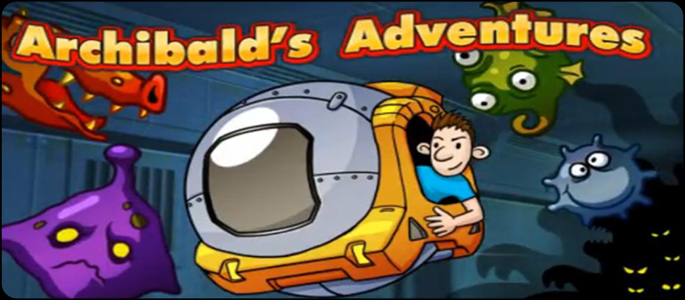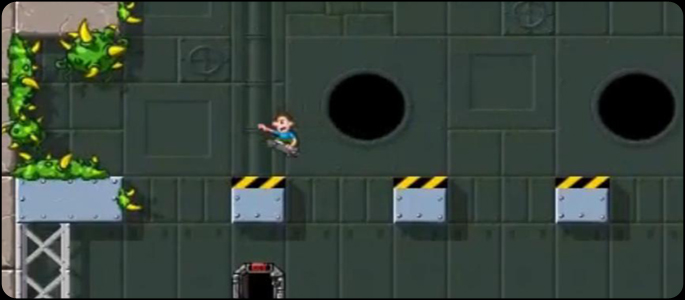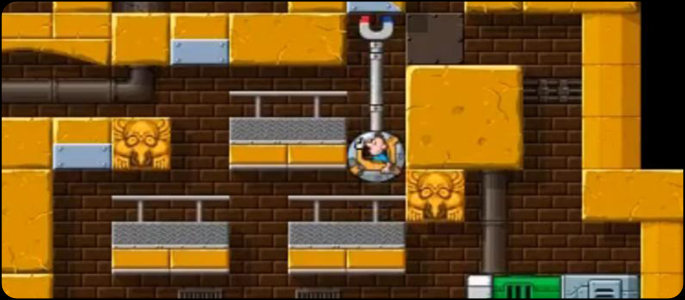
While a lot of companies have started trawling through their back catalog, looking for old franchises they can reboot in the hope of making a quick buck off the back of fan service, the folks over at Rake in Grass have gone in a slightly different direction. From the moment you start up Archibald’s Adventures, the game strikes you as a something that would genuinely feel more at home in the 1980s than on minis: the 2D platform based gameplay, the souped up sprite motif and the Archie-wannabe skater kid who falls into a sewer trying to pull off a rad jump all feel reminiscent of games that you would normally find imprinted on NES cartridges. However, Archibald’s Adventures isn’t just your typical retread of every old 8 bit puzzle-platformer, this game packs in a lot of ideas of its own.
For the first couple of chapters, Archibald and his skateboard are practically inseparable (I like to think it’s because of a strong emotional attachment, perhaps being the embodiment of some deep rooted father issues.) Because of this, Archibald’s Adventures doesn’t use the standard control mechanics that we’re all familiar with. Instead of needing to press a button to jump, Archie will trick his way up small enough obstacles automatically. You just need to run into it and you’ll immediately start jumping over it. This auto-jump function brings a great sense of flow to the game and it really shines during the platform traversal sections. When you reach the end of a platform, you’ll either jump across the gap if you’ve built up enough speed or you’ll drop limply off the edge if you haven’t, however, to go quickly enough to jump, you need a sufficient run up. This means that levels can be set up in such a way as to include some simple puzzles in the way you get from A to B (which usually involves going via C, D and possibly E.)
Think of it as like Mario’s take on a parkour game; some levels can have you skipping over four or five platforms at a time, with the monsters underneath providing an appropriate discouragement for failure. These monsters aren’t what you’d usually find in Mario though, more like what you’re be left with when a goomba takes a quick dip in some radioactive waste (the game does take place in a sewer after all.) Along with avoiding monsters, Archie also also has levers, buttons and crates to deal with however they usually require a bit more creativity to reach than just casually ollie-ing over to them.

These are the basics of Archibald’s Adventures but as you make your way through the game, you’ll come across a whole host of new and exciting wonderments to have a mess around with. The first of which is controllable bubbles of gum which are used to reach areas that you wouldn’t have been able to get to otherwise. This gum probably isn’t the sort you’d find lying around on store shelves; not only can it switch levers and press buttons, but it can lift some fairly hefty crates — I’m thinking it must be industrial strength. When controlling the bubble, you have to be wary of fans, spikes and leaking pipes of acid which cause the bubbles to burst. In keeping with the puzzle style of the game, the developers have used these hazards to set up some fiendish, yet no less rewarding, puzzles for you to conquer.
After playing around with gum for a while, the game commits an act of emotional barbarity and rips the skateboard from Archie’s clenching hands, breaking a bond that was meant to last the ages — as it turns out, he’s fine with it. Because in its place, Archie finds a prototype metal pod thing, sort of like a mechanical hula-hoop which brings with it a number of exciting bolt-ons. For a start, it includes a ‘go-go-gadget-magnet’ feature: an extendo-arm which can reach up and pull you onto metal ceilings. Of course, the magnet doesn’t just work on the ceiling, it can be used on the floor and walls too. Unsurprisingly, this act of treason against gravity can get you into some pretty nifty places and adds even more to the already expansive gameplay.
I could go on explaining all of the different gameplay traits you’ll run in to on your perilous adventure but I’d be writing for quite a long time. All you need to know is that by the last chapter, you’ll have a firm grasp of the methods and intricacies present in Archibald’s Adventures. In fact, possibly the most impressive thing about the game, especially considering it’s a mini, is the length. The game boasts 191 playable levels crammed into the meager 20Mb file size. What’s really laudable though is that it does this without ever succumbing to repetition. Every level presents you with a fresh challenge which you complete with your established skill set. Of course, the game also throws the odd curve ball; one of the chapters has you take control of the jetpack wielding professor who concocted these mechanical marvels.

There are, however, a couple of small annoyances that crop up from time to time. Make no mistake, the platforming controls are what make this game unique but when it comes to controlling the bubble and, to some extent, the professor, it can be quite annoying. In a bid to make the controls more ‘realistic’, the bubble moves fairly slowly and feels the need to bounce off everything in sight, meaning that trying to do something in confined spaces (which the game often presents you with) can be very frustrating. I understand what the developers tried to do in making the controls feel a little different but all they really did was make them feel unresponsive and a chore to use. The game’s use of checkpoints also feels like it hasn’t been thought through enough. At times, you may be working on solving a puzzle and in doing so will unwittingly trap yourself underneath some crates or you may block the exit. This can becomes a regular occurrence and since there’s no restart from checkpoint option, all you can do is restart the level from the very beginning.
Presentation-wise, the game is a bit of a mixed bag. The comic style opening, telling the story of how Archie ended up in the sewer, is bland and boring. The in-game graphics however are sharp and exciting and look very much like the minimalist style of yore given a modern day touch up. The game looks great on the small PSP screen but, like most minis, suffers when being emulated on PS3. The sound effects in the game aren’t too bad either, hardly the peak of audio engineering but still nice enough to listen to. The soundtrack however is quite dull and the three or four songs in the game get old very fast. However, these are all nitpicks, compared with the fantastic gameplay these minor flaws are more than tolerable.
Overall, Archibald’s Adventures is quite simply brilliant value for money. The seamless mix of platforming and puzzle solving makes for a refreshing take on an aged genre and its plethora of levels certainly helps it stand out among the more basic of minis. However. the experience is slightly marred by some bad control decisions and a poor use of checkpoints but these are just minor inconveniences that shouldn’t stop you from playing this great addition to the minis library.
PlayStation LifeStyle’s Final Score
Includes a wealth of levels that don’t succumb to repetition. Controls can be a slight annoyance. |
 |
–








